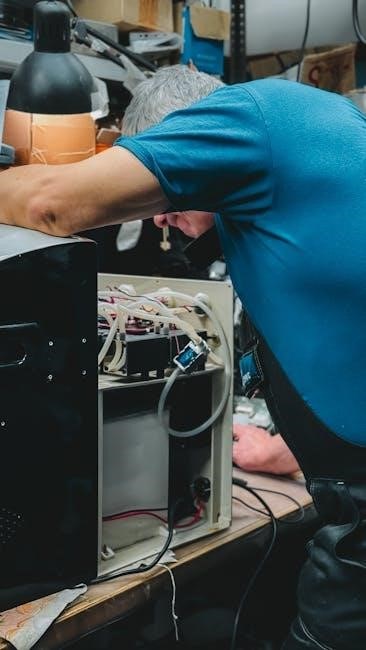The Silent Knight 5207 Manual provides comprehensive guidance for installing, operating, and maintaining the fire alarm panel, ensuring compliance with NFPA 72 standards and optimal system performance.
1.1 Overview of the Silent Knight 5207 Fire Alarm Panel
The Silent Knight 5207 is a UL-listed fire alarm panel designed with advanced microprocessor technology for reliable 24-hour fire protection. It supports manual and automatic fire alarms, making it ideal for local protected fire alarm systems. The panel is user-friendly, combining a built-in touchpad for easy operation with a robust design to ensure compliance with NFPA 72 standards. Its features include flexible programming options, zone configurations, and communication capabilities, making it a versatile solution for commercial fire safety needs. Designed for simplicity, it balances sophistication with ease of use.
1.2 Importance of the Manual for System Operation
The manual is essential for understanding the Silent Knight 5207’s features, installation, and operation. It provides critical instructions for configuring zones, troubleshooting, and maintaining compliance with fire safety codes like NFPA 72. The guide ensures users can operate the system effectively, handle emergencies, and perform routine maintenance. Proper use of the manual guarantees reliable fire protection and adherence to safety standards, making it indispensable for both installers and end-users. It must be displayed near the panel for quick reference during operation and testing.

System Overview
The Silent Knight 5207 is a UL-listed fire alarm panel designed for local protected systems, offering reliable 24/7 fire protection with advanced microprocessor technology and user-friendly operation.
2.1 Key Features of the Silent Knight 5207
The Silent Knight 5207 features a built-in touchpad for intuitive operation, advanced microprocessor technology for reliable performance, and compatibility with optional accessories like the Model 5230 Remote Annunciator. It supports both manual and automatic fire alarm operations, ensuring comprehensive fire protection. The system is designed for local protected fire alarm applications and is UL-listed, meeting stringent safety standards. Additional features include flexible programming options and communication capabilities with Silent Knight receivers, enhancing its functionality and adaptability for various installations.

2.2 UL Listing and Compliance with Fire Codes
The Silent Knight 5207 is UL-listed and designed to meet NFPA 72 standards for fire alarm systems, ensuring reliability and compliance with fire safety regulations. It adheres to local protected fire alarm system requirements, providing dependable protection for businesses. The system’s UL certification guarantees adherence to rigorous testing and safety standards, while its compliance with fire codes ensures proper installation and operation. This makes the Silent Knight 5207 a trusted choice for fire alarm solutions in various commercial settings.
2.3 Designed for Local Protected Fire Alarm Systems
The Silent Knight 5207 is specifically designed for local protected fire alarm systems, meeting the requirements of NFPA 72 for reliable fire detection and notification. It supports both manual and automatic fire alarm activations, ensuring prompt emergency responses. The system’s design integrates seamlessly with local fire safety protocols, providing a robust solution for businesses needing dependable fire protection. Its features are tailored to address the unique demands of local fire alarm applications, making it a versatile and effective choice for commercial environments.

Installation and Setup
The Silent Knight 5207 requires careful pre-installation planning, proper physical installation, and precise wiring to ensure compliance with fire codes and optimal system functionality.
3.1 Pre-Installation Requirements
Before installing the Silent Knight 5207, ensure compliance with NFPA 72 standards and local fire codes. Verify the system’s compatibility with existing infrastructure and power requirements. Review the manual thoroughly to understand hardware and software specifications. Ensure all necessary tools and materials are available. Confirm the panel’s placement adheres to environmental guidelines, avoiding extreme temperatures and humidity. Proper preparation ensures a smooth and safe installation process, minimizing potential issues during setup and operation.
3.2 Physical Installation of the Panel
Mount the Silent Knight 5207 panel in a secure, easily accessible location, ensuring it is level and protected from environmental hazards. Follow NFPA 72 guidelines for placement in fire alarm systems. Connect the panel to a dedicated 24V power supply, as earlier models’ 12V option has been discontinued. Ensure all wiring is properly secured and meets UL standards for fire safety. The built-in touchpad should face outward for easy operation. Proper physical installation is crucial for reliable performance and compliance with fire codes. Always refer to the manual for specific mounting instructions.
3.3 Wiring and Connections
Ensure the Silent Knight 5207 panel is wired correctly, using the specified 24V power supply, as 12V functionality has been discontinued. Connect all zones, devices, and communication lines according to the manual’s wiring diagram. Use FSK or SK 42 format for communication with compatible receivers. Verify all connections meet UL and NFPA standards for fire safety. Proper wiring ensures reliable system operation, accurate alarm signaling, and compliance with fire codes. Regularly inspect wiring for damage or wear to maintain optimal performance and safety.

Operating Instructions
This section covers the Silent Knight 5207’s daily operations, detailing the use of the built-in touchpad for basic functions, testing, resetting, and silencing the system effectively.
4.1 Using the Built-in Touchpad
The built-in touchpad on the Silent Knight 5207 panel allows users to navigate through menus and perform essential functions with ease. It provides a user-friendly interface for daily operations, including arming, disarming, and monitoring the system. The touchpad displays real-time status updates and alarms, enabling quick responses to emergencies. Function keys are clearly labeled for intuitive operation, ensuring that even less experienced users can manage the system effectively. Regular use of the touchpad ensures compliance with NFPA 72 standards and maintains reliable fire protection for your facility.
4.2 Basic Functions and Keystrokes
The Silent Knight 5207 panel’s basic functions are accessed via specific keystrokes on the touchpad. Users can perform actions like system testing, silencing alarms, and resetting the panel. Key functions include arming/disarming zones, acknowledging alarms, and accessing event logs. Dedicated keys simplify operations, while soft keys provide menu-driven navigation. The manual details essential keystrokes, ensuring users can efficiently manage the system. Regular practice of these functions ensures smooth operation and compliance with fire safety standards, making the 5207 both powerful and user-friendly for all skill levels.
4.3 Testing, Resetting, and Silencing the System
The Silent Knight 5207 allows users to test, reset, and silence the system efficiently. Testing ensures all components function correctly, while resetting restores the system to its normal state after an alarm. Silencing disables audible alerts without affecting monitoring. These operations are essential for maintenance and emergency situations. The manual provides step-by-step instructions for each process, ensuring compliance with NFPA 72 standards. Proper execution of these functions guarantees reliable fire protection and minimizes downtime, making the 5207 a robust solution for fire safety needs.
Programming the System
Programming the Silent Knight 5207 involves configuring zones, devices, and communication parameters to meet specific fire alarm requirements. The manual guides users through setup and customization.
5;1 Understanding Programming Modes
The Silent Knight 5207 offers multiple programming modes to customize system settings. Normal mode allows basic configuration, while Program mode enables advanced adjustments. Test mode ensures proper functionality. Accessing these modes requires specific passcodes to prevent unauthorized changes. The manual provides detailed instructions for navigating and utilizing each mode effectively. Proper understanding of these modes is essential for configuring zones, devices, and communication parameters accurately. Adhering to the manual ensures compliance with NFPA 72 standards and optimal system performance for fire safety.
5.2 Configuring Zones and Devices
Configuring zones and devices on the Silent Knight 5207 involves defining detection zones and assigning devices such as smoke detectors, pull stations, and horns. Each zone must be programmed with specific settings, including response types and sensitivity levels. The manual guides users through the process of mapping devices to zones and ensuring proper communication. Proper configuration ensures reliable fire detection and alarm responses. Regular verification of zone and device settings is crucial for maintaining system integrity and compliance with fire safety standards.
5.3 Setting Up Communication Parameters
Setting up communication parameters for the Silent Knight 5207 involves configuring the panel to send signals to central stations or other devices. The panel uses FSK and SK 42 formats for communication. The FSK format is a type of modulation, while SK 42 is a specific protocol developed by Silent Knight. The Model 8520 Receiver, for instance, requires combining event types and zone numbers into a single message due to its two-digit alarm code limitation. This means each zone must be programmed with a unique identifier to avoid confusion during an alarm event. Configuring these settings typically involves using the built-in touchpad or a separate programming interface. It’s important to select the correct format (FSK or SK 42) based on the receiver being used, such as Silent Knight, Ademco, or Radionics. After configuration, testing the setup by triggering a test alarm and verifying reception by the central station is crucial. Troubleshooting may involve addressing issues like incorrect format selection or wiring problems, with guidance provided in the manual’s troubleshooting section. Ensuring compatibility and accurate configuration is essential for reliable communication and proper system function.

Maintenance and Troubleshooting
Regular maintenance ensures the Silent Knight 5207 operates reliably. Check all components, update firmware, and address issues promptly to prevent system failures. Troubleshooting guides are provided in the manual for common problems.
6.1 Regular Maintenance Requirements
Regular maintenance is essential to ensure the Silent Knight 5207 operates effectively. Inspect all system components, clean sensors, and test circuits to verify functionality. Check for dust or debris that may interfere with performance. Replace worn or damaged parts promptly. Update firmware to the latest version for optimal operation. Keep the panel area clean and free from obstructions. Refer to the manual for detailed maintenance schedules and procedures to comply with NFPA 72 standards and ensure reliable fire protection.
6.2 Common Issues and Solutions
Common issues with the Silent Knight 5207 include false alarms, power supply problems, and communication failures. For false alarms, check sensors for dust or debris and clean as needed. Power issues may require checking the 24V supply and ensuring connections are secure. Communication failures can be resolved by verifying the correct format (FSK or SK 42) and ensuring the panel is properly configured. Refer to the manual for troubleshooting steps and solutions to restore system functionality and reliability, ensuring continuous fire protection.
6.3 Diagnostic Tools and Techniques
The Silent Knight 5207 manual provides detailed diagnostic tools and techniques to identify and resolve system issues. The built-in touchpad allows users to access event logs, troubleshoot errors, and perform system tests. Regularly reviewing these logs helps pinpoint common problems, such as sensor malfunctions or communication errors. Additionally, the manual recommends using test modes to simulate alarm conditions and verify system responsiveness. By following these diagnostic procedures, users can ensure optimal performance and resolve issues promptly, maintaining reliable fire protection and compliance with safety standards.

Compliance and Certification
The Silent Knight 5207 is UL listed and FM approved, ensuring compliance with NFPA 72 and fire codes. Proper installation and maintenance are required to uphold certifications.
7.1 NFPA 72 Compliance
The Silent Knight 5207 fire alarm panel is designed to meet NFPA 72 standards for fire alarm systems. It ensures reliable performance in detecting and signaling fires, with features like automatic notifications and system monitoring. Compliance is verified through rigorous testing and certification processes. Proper installation, programming, and maintenance are essential to maintain NFPA 72 adherence. The manual provides detailed instructions for configuring the system to meet these standards, ensuring safety and regulatory compliance for protected premises. Adherence to these guidelines is critical for reliable fire protection systems.
7.2 FM Approval and Other Certifications
The Silent Knight 5207 fire alarm panel is FM approved under project OQ1A3.AY when used with the Model 9000 Receiver, ensuring it meets rigorous safety and performance standards. Additionally, it is UL listed, further verifying its reliability and compliance with industry regulations. These certifications confirm the system’s ability to provide dependable fire protection. The panel also supports optional accessories and compatible devices that maintain certification. Adherence to FM and UL standards ensures the system operates effectively and safely, meeting the needs of protected premises while upholding regulatory requirements.
7.4 Documentation Requirements
Proper documentation is essential for the Silent Knight 5207 system. The Model 5207 Operators Guide must be displayed next to the panel, as required by NFPA 72. This ensures quick access to operational procedures and compliance with fire safety regulations. All system configurations, test results, and maintenance records should be documented and stored securely. Detailed records help verify compliance and provide a reference for future inspections. Accurate documentation also supports troubleshooting and ensures the system operates efficiently over its lifespan.

Accessories and Optional Features
The Silent Knight 5207 supports optional accessories like the Model 5230 Remote Annunciator and compatible receivers/communicators, enhancing system functionality and meeting specific installation needs.
8.1 Model 5230 Remote Annunciator
The Model 5230 Remote Annunciator is a key accessory for the Silent Knight 5207 system, offering remote monitoring and control capabilities. Designed for flexibility, it allows users to monitor and acknowledge alarms, silence bells, and perform basic system tests from a remote location. The annunciator features an LCD display, a keypad for input, and LED indicators for system status. It is ideal for installations requiring centralized monitoring or for use in areas where the main panel is not easily accessible. This accessory enhances system functionality and user convenience.
8.2 Compatible Receivers and Communicators
The Silent Knight 5207 system is compatible with select receivers and communicators, ensuring reliable monitoring and communication. The Model 8520 Receiver is specifically designed to work with the 5207, supporting both FSK and SK 42 communication formats. Other compatible models include the Model 9000 Receiver, which offers advanced features and FM approval. These devices enable seamless integration with central station monitoring systems, ensuring timely alerts and responses. Compatibility ensures reliable performance, meeting NFPA 72 and UL standards for fire alarm systems. This integration enhances system functionality and user confidence.
8.3 Additional Hardware and Software Options
Beyond the core system, the Silent Knight 5207 supports various additional hardware and software options to enhance functionality. Optional accessories include remote annunciators like the Model 5230, which provides flexible monitoring capabilities. Software tools enable advanced programming and diagnostics, ensuring customized system configurations. These options integrate seamlessly with the 5207, offering enhanced control and monitoring. They are designed to meet specific installation requirements while maintaining compliance with fire safety standards. Expanding the system with these components ensures optimal performance and adaptability to diverse applications. This versatility makes the 5207 a robust solution for fire alarm needs.

Frequently Asked Questions
Users often inquire about system operation, troubleshooting, and programming. The 5207 manual addresses these topics, providing clear solutions and guidelines for optimal system functionality.
9.1 Common User Queries
Common questions about the Silent Knight 5207 include understanding basic functions, troubleshooting error codes, and navigating the built-in touchpad. Users also inquire about testing procedures, resetting the system, and programming zones. Many seek clarification on NFPA 72 compliance and proper maintenance routines. Additionally, queries often revolve around silencing alarms, interpreting system codes, and resolving common issues like false alarms or communication failures. The manual provides clear guidance and step-by-step instructions to address these concerns, ensuring efficient system operation and troubleshooting.
9.2 Clarifications on System Operation
The Silent Knight 5207 operates as a UL-listed fire alarm panel, designed for local protected systems. It features a built-in touchpad for intuitive control, with functions like testing, resetting, and silencing alarms. Programming modes allow customization of zones and communication settings. The system is compliant with NFPA 72, ensuring reliable fire protection. Users can access basic functions and advanced configurations, making it versatile for various applications. Proper operation requires adherence to the manual’s guidelines to maintain system integrity and performance. Regular maintenance and updates are essential for optimal functionality.
9.3 Troubleshooting Frequently Encountered Issues
Common issues with the Silent Knight 5207 include power supply problems, faulty sensors, and communication errors. Users should first check the panel’s power connections and ensure all wires are securely connected. For sensor-related issues, inspect for dust or damage and clean or replace as needed. Communication failures may require reconfiguring settings or updating software. Refer to the manual for detailed diagnostic tools and step-by-step solutions to resolve these issues effectively, ensuring the system operates reliably and maintains fire safety standards.
The Silent Knight 5207 Manual ensures optimal system operation, compliance with fire codes, and reliable fire protection. Regular maintenance and adherence to guidelines are essential for maximizing its performance and safety features.
10.1 Summary of Key Points
The Silent Knight 5207 Manual is an essential resource for understanding and managing the fire alarm system, ensuring compliance with fire codes like NFPA 72. It highlights the panel’s advanced features, such as the built-in touchpad, remote annunciators, and customizable zones. Proper installation, regular maintenance, and adherence to troubleshooting guidelines are emphasized to maintain system reliability. Users are encouraged to familiarize themselves with programming modes and communication settings to optimize performance. Regular system reviews and updates are recommended to ensure ongoing safety and efficiency.
10.2 Final Tips for Effective System Usage

Regularly review the Silent Knight 5207 Manual to stay updated on system features and maintenance requirements. Familiarize yourself with the touchpad interface for quick access to controls. Schedule routine inspections and testing to ensure optimal performance. Use the remote annunciator for enhanced monitoring flexibility. Always follow NFPA 72 guidelines for compliance. Keep backup power sources ready to maintain functionality during outages. Lastly, consult the manual for troubleshooting common issues to minimize downtime and ensure continuous fire protection for your facility.
